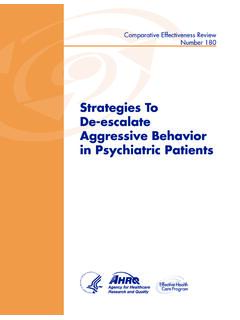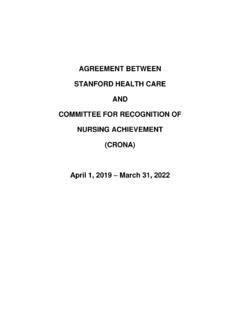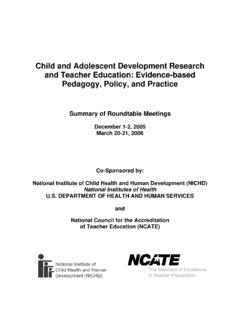Transcription of Prolonged Grief Disorder
1 Prolonged Grief Disorder : Diagnostic, Assessment, and TreatmentConsiderationsAlexander H. Jordan and Brett T. LitzVA Boston Healthcare System, Boston, Massachusetts, and Boston University School of MedicineNormative bereavement reactions are contrasted with Prolonged Grief Disorder (PGD). Diagnosticcriteria for PGD are reviewed. PGD is distinguished from other problems occurring after loss,namely depression and PTSD. Assessment approaches are described. Recent clinical trials arereviewed, and recommendations for the psychotherapeutic treatment of PGD are developed. Con-sideration of medication referral is also recommended, especially in the case of : Prolonged Grief , complicated Grief , pathological Grief , traumatic Grief , psychotherapyNearly every life includes the loss of a loved one, and nearlyevery psychologist s professional life includes encounters withpatients for whom such a loss causes unusually Prolonged anddisabling Grief . In this paper, we review the growing literature onprolonged Grief Disorder (PGD), alternatively called complicatedgrief, pathological Grief , or traumatic Grief .
2 We begin with anoverview of normative bereavement reactions. We then describediagnostic criteria for PGD, the distinction between PGD and otherdisorders, and assessment instruments that can help cliniciansidentify PGD. Next, we describe treatments that have shownefficacy in reducing PGD symptoms. We conclude by identifyingcommon components of effective treatments and offering recom-mendations to the practicing Bereavement ReactionsMany types of loss can have a profound effect on people spsychological functioning; in this paper, we focus exclusively onadults reactions to the loss of another person through individuals often find themselves yearning intensely forthe lost loved one. In the weeks and months after a loss, this grieftypically begins to abate. The bereaved gradually reengages inpleasurable activities and reattaches to significant others. In aprospective study of individuals followed from before the death ofa loved one to 18 months afterward, the most common trajectory,endorsed by 45% of the sample, was one in which depressivesymptoms remained low and Grief symptoms had largely resolvedby 18 months postloss (Bonanno et al.)
3 , 2002). Less than a quarterof the sample followed trajectories in which they continued toshow elevated Grief symptoms at the end of the study. Thus, mostpeople eventually arrive at a new emotional equilibrium after loss,without developing any Prolonged impairment. Indeed, somehealthy individuals do not show significant distress or impairmenteven shortly after a major loss (Wortman & Silver, 1989).Although the normal grieving process is not fully understood,one prominent theory holds that healthy grieving typicallyinvolves completion of loss-focused tasks and restoration-focused tasks (Stroebe & Schut, 1999). The griever confrontsloss stressors when doing things that involve engagement withstimuli that serve as reminders of the reality of the loss, such aslooking through old photos of or sharing stories about thedeceased. This emotionally taxing work is balanced by periodsof withdrawal from loss stressors; the griever s attention oscil-lates between evocative echoes of the past and present-focusedactivities (see also Horowitz & Reidbord, 1992).
4 At the sametime that the griever learns to cope with doses of loss stressors,he or she also focuses on the restoration of everyday lifefunctions that depended critically on the lost loved one. Forexample, the bereaved may need to learn how to manage his orher own finances or cooking, and he or she may need to seek outnew sources of social and emotional support and companion-ship. Through the completion of loss- and restoration-focusedtasks, the griever is able to come to an acceptance of irrevoca-bly changed circumstances and reengage in the natural resilience or recovery that mostgrievers demonstrate, many psychotherapy trials have beenaimed at alleviating Grief reactions irrespective of severity orALEXANDERH. JORDAN earned his PhD in psychology from StanfordUniversity. He is currently a clinical research fellow in the MassachusettsVeterans Epidemiological Research and Information Center at the VABoston Healthcare System, Boston, Massachusetts, a teaching fellow in theDepartment of Psychiatry at Boston University, and an adjunct assistantprofessor in the Tuck School of Business and the Center for health CareDelivery Science at Dartmouth College.
5 His research spans clinical, social,and organizational LITZ earned his PhD in clinical psychology from the StateUniversity of New York at Binghamton. He is a professor in the Depart-ments of Psychiatry and Psychology at Boston University and the directorof the Mental health Core of the Massachusetts Veterans EpidemiologicalResearch and Information Center at the VA Boston Healthcare System,Boston, Massachusetts. His research is focused on evaluating the mentalhealth outcomes associated with military deployments across the lifespan,with an emphasis on early intervention for combat and operational traumaand CONCERNING THIS ARTICLE should be addressed toAlexander H. Jordan, VA Boston Healthcare System (116B-4), 150 SouthHuntington Avenue, Boston, MA 02130-4893. E-mail: Psychology: Research and PracticeIn the public domain2014, Vol. 45, No. 3, 180 187 An exhaustive meta-analysis of 61 Grief treatmenttrials found that active psychotherapies produced small to mod-erate reductions in Grief symptoms ( , yearning for the de-ceased) compared with control conditions; however, at long-term follow-up, there was no difference, on average, betweenoutcomes for the treatment and control conditions, with controlparticipants Grief improving with time rather than worsening(Currier, Neimeyer, & Berman, 2008).
6 Regardless of the demo-graphics of the targeted population ( , women vs. men), grieftherapies generally failed to show any long-lasting benefit fornormative Grief reactions. Consequently, there is a growingconsensus in the field that interventions aimed at redressingnormative Grief reactions are contraindicated ( , Bonanno &Lilienfeld, 2008; Neimeyer, 2000). Defenders of normativegrief counseling have argued that there exists little to no peer-reviewed evidence of harm from such treatments (Larson &Hoyt, 2007) and that if such therapy can merely accelerate thenatural healing process for most patients, then reducing theduration of grievers distress and impairment may still be aworthy clinical goal (Hoyt & Larson, 2010). However, evenadvocates of treatment for normative Grief have cautioned thatmeta-analyses ( , Allumbaugh & Hoyt, 1999; Currier et al.,2008) have indicated that universally applied Grief treatments( , as found in treatment studies that have used aggressiverecruitment procedures) are likely ineffective, and that insteadtreatment of normal Grief should be aimed at self-referred orclinically referred patients (Hoyt & Larson, 2010).
7 Although there is some debate about the appropriateness ofoffering treatment to individuals exhibiting normative Grief reac-tions, Currier et al. s (2008) meta-analysis of Grief therapy trialsshowed clear, substantial, and long-lasting benefits for a subset ofindividuals, namely those suffering severe and Prolonged griefsymptomatology. Consequently, there is agreement even amongmany critics of normative Grief treatment ( , Bonanno & Lil-ienfeld, 2008) that intervention is indicated in cases of prolongedgrief. We now turn our attention to understanding and identifyingPGD before describing treatments that have shown efficacy intreating this Grief DisorderIn PGD, bereavement difficulties persist or grow rather thandiminishing with time. The prevalence of PGD varies; studies havefound fewer than 10% ( , Kersting, Brahler, Glaesmer, & Wag-ner, 2011) to as many as 20% ( , Shear, McLaughlin, et al.,2011) of bereaved individuals developing PGD.
8 Several risk fac-tors have been identified. A history of prior trauma or loss, ahistory of mood and anxiety disorders , insecure attachment style,being a caregiver for the deceased, a violent cause of death ( ,suicide), and a lack of social support after the loss predict greaterlikelihood of developing PGD ( , Lobb et al., 2010). Thesefactors appear to predispose individuals toward intense longing forthe deceased, thwarting the loss-processing and functional resto-ration tasks that ordinarily lead to resolution of Grief . Failure tofully face the reality of the loss may prolong emotional reactivityto loss reminders, while avoidance of loss reminders, unwilling-ness to adopt new roles, and an aversion to seeking support fromnew individuals may constrict a person s behavioral repertoire andprevent him or her from discovering new sources of meaning andpleasure. Disengaged from the social sphere, the bereaved maythus keep his or her attention narrowly fixed on the past and themeaning, pleasure, and intimacy it contained before the loss of theloved CriteriaAlthough clinicians have long noted the distinctive phenome-nology of Prolonged Grief reactions, rigorous research on theclinical features of PGD has accumulated only over the last 2decades, and previous editions of the International Classificationof Diseases (ICD) and theDiagnostic and Statistical Manual ofMental disorders (DSM) have not included diagnoses correspond-ing to Prolonged Grief problems.
9 Instead, they have included Z or V codes acknowledging bereavement as a possible focus ofclinical attention or as a reason that individuals may seek mentalhealth working group for the next edition of the ICD recentlyrecommended adding a diagnosis of PGD to ICD-11 (Maercker etal., 2013). The group recommended diagnostic criteria (see Table1) based on an interview study of nearly 300 bereaved individualsthat used state-of-the-art psychometric validation methods to iden-tify the central distinguishing clinical features of PGD (Prigersonet al., 2009). The recently releasedDSM-5(American PsychiatricAssociation, 2013) also includes a diagnostic code correspondingto Prolonged Grief problems Other Specified Trauma- andStressor-Related Disorder , Persistent Complex Bereavement Dis-order (PCBD) with criteria for this diagnosis contained in thesection of the manual devoted to conditions needing further working criteria (see Table 1) draw in part on the validationstudy informing the proposed ICD-11 criteria (Prigerson et al.)
10 ,2009) as well as a further study of nearly 800 bereaved individu-als symptoms (Simon et al., 2011). Although there is overlapbetween theDSM-5diagnosis of PCBD and the proposed ICD-11diagnosis of PGD, critics have voiced concern that some of thesymptoms unique to theDSM-5diagnosis ( , difficulty posi-tively reminiscing about the deceased) do not have empiricalsupport as markers of dysfunctional Grief , there is less evidencesupporting the 12-month compared with the 6-month criterion, andtheDSM-5diagnosis is enormously heterogeneous ( , Boelen &Prigerson, 2012). A future revision of theDSM-5that finalizes thecriteria for PCBD and moves the diagnosis to the main section ofthe manual may address these and other issues. In the meantime,should clinicians prefer to use the proposed ICD-11 criteria fordiagnosing PGD, one option for those working in settings thatrequireDSM-5diagnoses is to use the Unspecified Trauma- andStressor-Related Disorder diagnosis for cases that do not meet thePCBD working criteria but do meet the proposed ICD-11 Versus Other DisordersThe disruption associated with bereavement can trigger variousdisorders, including not only PGD but also major depression andposttraumatic stress Disorder (PTSD).
















